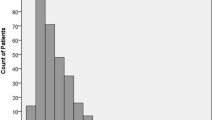Abstract
Background
The purpose of this study was to determine perioperative professional fee payments to providers from different specialties for the care of patients undergoing inpatient open ventral hernia repair (VHR).
Methods
Perioperative data of patients undergoing VHR at a single center over 3 years were selected from our NSQIP database. 180-day follow-up data were obtained via retrospective review of records and phone calls to patients. Professional fee payments (PFPs) to all providers were obtained from our physician billing system for the VHR hospitalization, the 180 days prior to operation (180Prior) and the 180 days post-discharge (180Post).
Results
PFPs for 283 cases were analyzed. Average total 360-day PFPs per patient were $3409 ± SD 3294, with 14.5% ($493 ± 1546) for services in the 180Preop period, 72.5% ($2473 ± 1881) for the VHR hospitalization, and 13.0% ($443 ± 1097) in the 180Postop period. The surgical service received 62% of PFPs followed by anesthesia (18%), medical specialties (9%), radiology (6%), and all other provider services (5%). Medical specialties received increased PFPs for care of patients with COPD and HCT < 38% ($90 and $521, respectively) and for the pulmonary complications ($2471) and sepsis ($2714) that correlated with those patient comorbidities; surgeons did not. Operative duration, mesh size, and separation of components were associated with increased surgeon PFPs (p < .05). At 6 months, wound complications were associated with increased surgeon and radiology payments (p < .01).
Conclusions
Management of acute comorbid conditions and the associated higher postoperative morbidity is not reimbursed to the surgeon under the 90-day global fee. These represent opportunity costs of care that pressure busy surgeons to select against these patients or to delegate more management to their medical specialty colleagues, thereby increasing total system costs. A comorbid risk adjustment of procedural reimbursement is warranted. In negotiating bundled payments, surgeon groups should keep in mind that surgeon reimbursement, unlike medical specialty and hospital reimbursement, have been bundled since the 1990s.

Similar content being viewed by others
References
Zavlin D, Jubbal KT, Van Eps JL, Bass BL, Ellsworth WA, Echo A, Friedman JD, Dunkin BJ (2018) Safety of open ventral hernia repair in high-risk patients with metabolic syndrome: a multi-institutional analysis of 39,118 cases. Surg Obes Rel Dis 14:206–213
Fields AC, Divino CM (2016) Surgical outcomes in patients with chronic obstructive pulmonary disease undergoing abdominal operations: an analysis of 331,425 patients. Surgery 159:1210–1216
Owei L, Swendiman RA, Kelz RR, Dempsey DT, Dumon KR (2017) Impact of body mass index on open ventral hernia repair: a retrospective review. Surgery 162:1320–1329
Liang MK, Goodenough CJ, Martindale RG, Roth JS, Kao LS (2015) External validation of the ventral hernia risk score for prediction of surgical site infections. Surg Infect 16:36–40
Fox SS, Janczyk R, Warren JA, Carbonell AM, Poulose B, Rosen MJ, Hope WW (2017) An evaluation of parastomal hernia repair using the Americas Hernia Society Quality Collaborative. Am Surg 83:881–886
Holihan JL, Alawadi Z, Martindale RG, Roth JS, Wray CJ, Ko TC, Kao L, Liang MK (2015) Adverse events after ventral hernia repair: the vicious cycle of complications. J Am Coll Surg 221:478–485
Carbonell AM, Criss CN, Cobb WS, Novitsky YW, Rosen MJ (2013) Outcomes of synthetic mesh in contaminated ventral hernia repairs. J Am Coll Surg 217:991–998
Cox TC, Blair LJ, Huntington CR, Schell S, Randolph D, Prasad T, Lincourt A, Heniford BT, Augenstein VA (2016) The cost of preventable comorbidities on wound complications in open ventral hernia repair. J Surg Res 2206:214–222
Plymale MA, Ragulojan R, Davenport DL, Roth JS (2017) Ventral and incisional hernia: the cost of comorbidities and complications. Surg Endosc 31:341–351
Fischer JP, Wes AM, Wink JD, Nelson JA, Rohrbach JI, Braslow BM, Kovach SJ (2014) Analysis of perioperative factors associated with increased cost following abdominal wall reconstruction (AWR). Hernia 18:617–624
Centers for Medicare and Medicaid Services. Medicare learning network. Medicare physician fee schedule. https://www.cms.gov/Outreach-and-Education/Medicare-Learning-Network-MLN/MLNProducts/downloads/medcrephysfeeschedfctsht.pdf. Accessed 27 Mar 2018
Department of Health and Human Services. Centers for medicare & medicaid services. Acute care hospital inpatient prospective payment system. https://www.cms.gov/Outreach-and-Education/Medicare-Learning-Network-MLN/MLNProducts/downloads/acutepaymtsysfctsht.pdf Accessed 27 March 2018
Centers for Medicare and Medicaid Services. https://www.cms.gov/Medicare/Quality-Initiatives-Patient-Assessment-Instruments/Value-Based-Programs/MACRA-MIPS-and-APMs/Quality-Payment-Program-MIPS-NPRM-Slides.pdf. Accessed 27 March 2018
Press MJ, Rajkumar R, Conway PH (2016) Medicare’s new bundled payments: design, strategy and evolution. JAMA 315:131–132
Regner JL, Mrdutt MM, Munoz-Maldonado Y (2015) Tailoring surgical approach for elective ventral hernia repair based on obesity and National surgical quality improvement program outcomes. Am J Surg 210:1024–1030
Plymale MA, Davenport DL, Roth JS (2017) Outcomes experienced by patients presenting with ventral hernia and morbid obesity in a surgical clinic. Am Surg 83:344–346
Gornick M (1993) Physician payment reform under medicare: monitoring utilization and access. Health Care Financ Rev 14:77–96
Author information
Authors and Affiliations
Corresponding author
Ethics declarations
Disclosures
Dr. Roth has consulting relationships with Bard, Allergan, and Miromatrix. He is a participant on a speaking bureau for Bard and Miromatrix. He has some stock ownership in Miromatrix. He receives research funding from Bard. Drs. Plymale, Davenport, and Hughes and Mr. Mirembo have no conflicts of interest or financial interests to disclose.
Rights and permissions
About this article
Cite this article
Davenport, D.L., Hughes, T.G., Mirembo, R.I. et al. Professional fee payments by specialty for inpatient open ventral hernia repair: who gets paid for treating comorbidities and complications?. Surg Endosc 33, 494–498 (2019). https://doi.org/10.1007/s00464-018-6323-9
Received:
Accepted:
Published:
Issue Date:
DOI: https://doi.org/10.1007/s00464-018-6323-9




